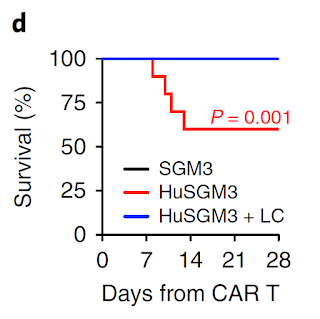During immune response to infection or vaccine antigen-specific T cells differentiate into various categories of effector/memory population. This is a stochastic process that follows some not yet fully understood "rules". New study in Cell suggests that one of those rules is a "date of birth" of individual CD8 T cells that participate in immune response.
For this study the authors used genetically modified mice where T cells could be permanently color-labeled after injection of tamoxifen (CD4 promoter-driven tamoxifen-inducible CRE mice, CD4cre-ERT2). When compared to each other, CD8 T cells produced early on during neonatal stage (day 1-7) harbored high proportion of cells with innate-like phenotype (CD44+/CD122+) than those CD8 T cells produced after day 28.
Similar phenotype was maintained even in mice where both day 1 and day 28 CD8 T cells were produced in the same mouse (following neonatal RFP+ thymus transplantation into YFP+ adult mice and analyzed at indicated time period post transplantation).
Notably, early-born CD8 T cells were characterized by heightened sensitivity to innate cytokines such IL-18 and IL-12 and rapid initial response to cognate antigen (between day 1-7 post-infection).
The authors opined that various categories of effector/memory T cells observed in other studies should be re-interpreted in light of "layered" CD8 T cells wherein CD8 T cells of different "date of birth" are producing different effector/memory T cell population.
It is certainly interesting observation. But there are several missing opportunities in this study. First, due to their innate-like phenotype, the authors should have looked at the role of microbiota in imprinting these features of early-born CD8 T cells. Second, it is not clear and the authors did not examined if biologically, lack of early-born vs. adult-born CD8 T cells, would have modified the host's response to infection. Third, the authors did not analyze whether early-born versus adult-born CD8 T cells differed in their TCR profile (even using transgenic CD8 T cells on WT background is not proper control). Fourth, different effector/memory categories have been produced by injection of a single CD8 T cells so individual CD8 T cells can indeed produce diverse phenotype of effector/memory T cells.
posted by David Usharauli
Similar phenotype was maintained even in mice where both day 1 and day 28 CD8 T cells were produced in the same mouse (following neonatal RFP+ thymus transplantation into YFP+ adult mice and analyzed at indicated time period post transplantation).
Notably, early-born CD8 T cells were characterized by heightened sensitivity to innate cytokines such IL-18 and IL-12 and rapid initial response to cognate antigen (between day 1-7 post-infection).
The authors opined that various categories of effector/memory T cells observed in other studies should be re-interpreted in light of "layered" CD8 T cells wherein CD8 T cells of different "date of birth" are producing different effector/memory T cell population.
It is certainly interesting observation. But there are several missing opportunities in this study. First, due to their innate-like phenotype, the authors should have looked at the role of microbiota in imprinting these features of early-born CD8 T cells. Second, it is not clear and the authors did not examined if biologically, lack of early-born vs. adult-born CD8 T cells, would have modified the host's response to infection. Third, the authors did not analyze whether early-born versus adult-born CD8 T cells differed in their TCR profile (even using transgenic CD8 T cells on WT background is not proper control). Fourth, different effector/memory categories have been produced by injection of a single CD8 T cells so individual CD8 T cells can indeed produce diverse phenotype of effector/memory T cells.
posted by David Usharauli








